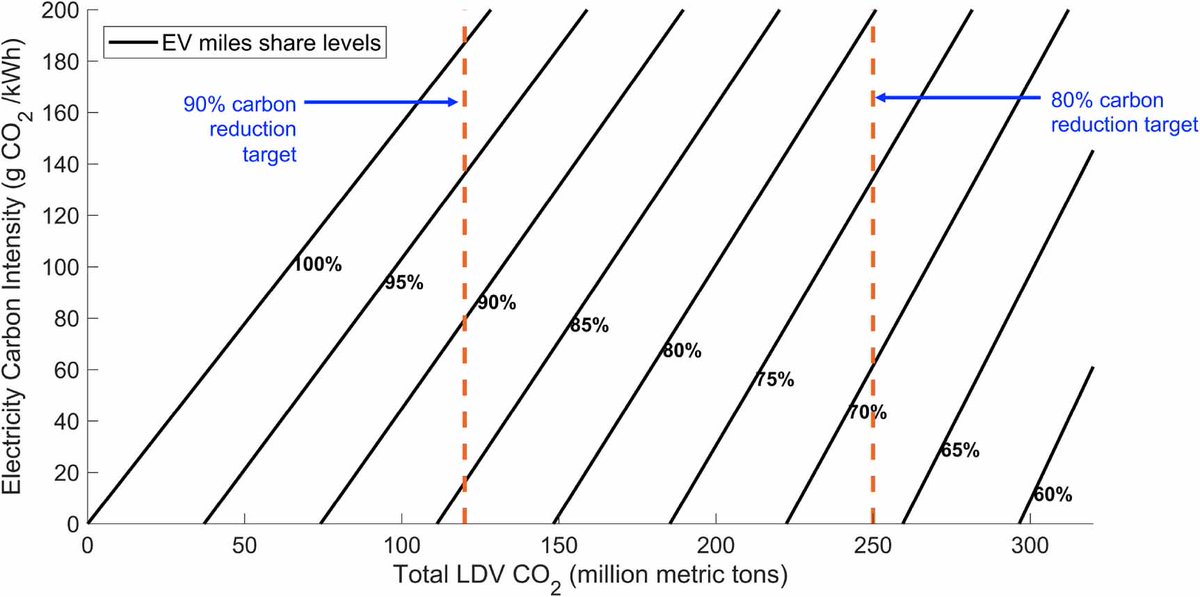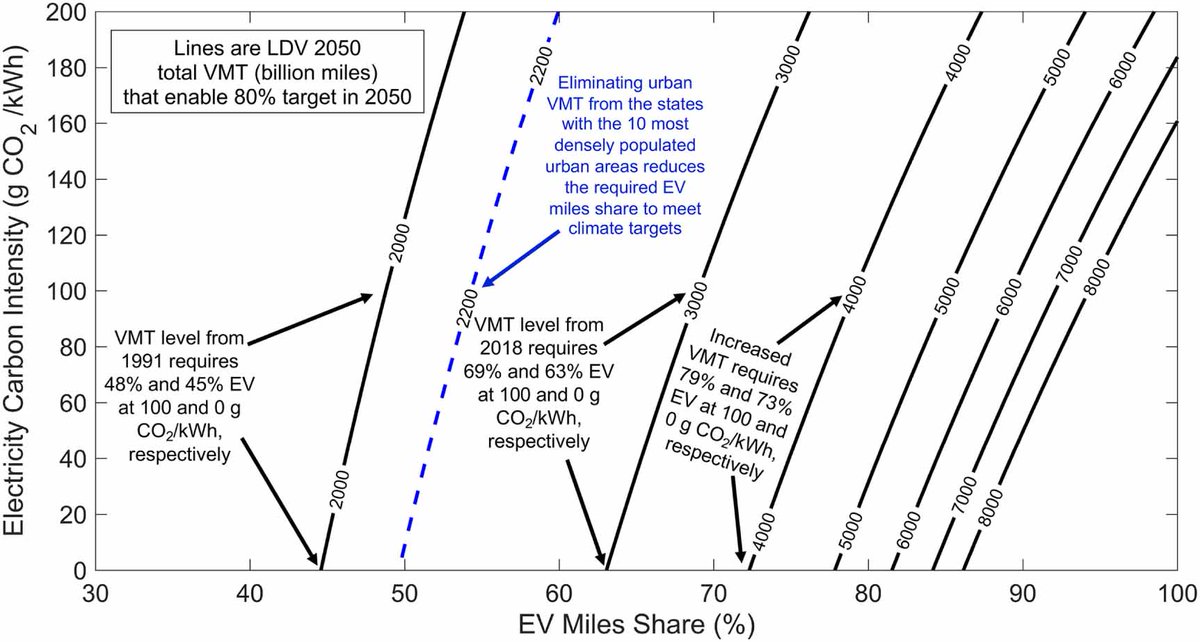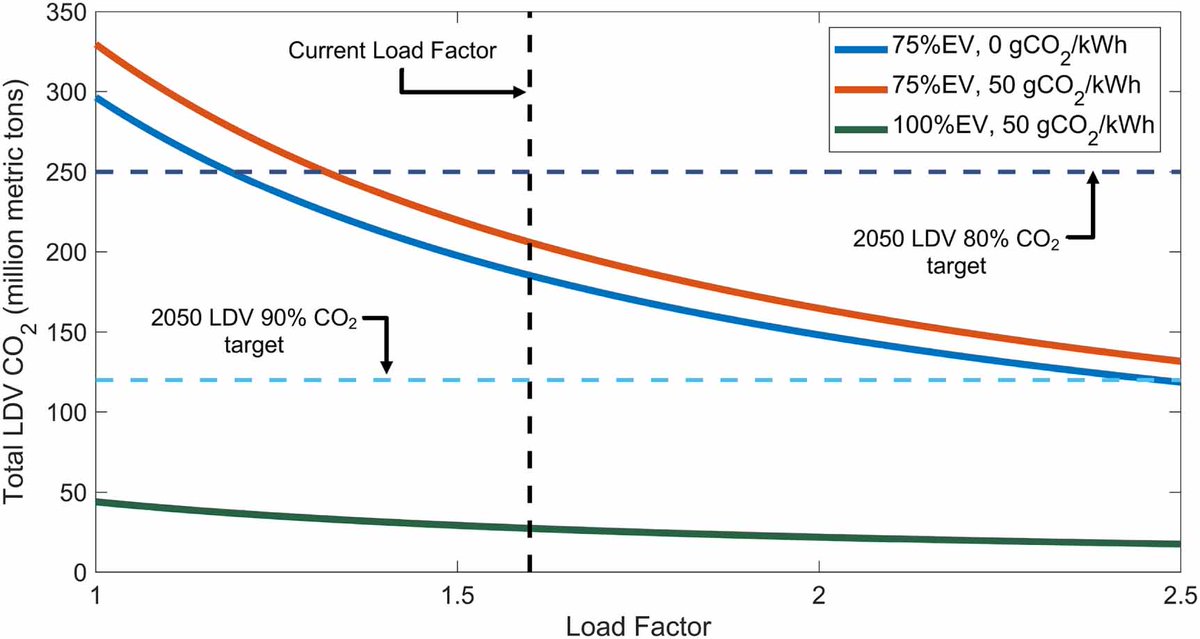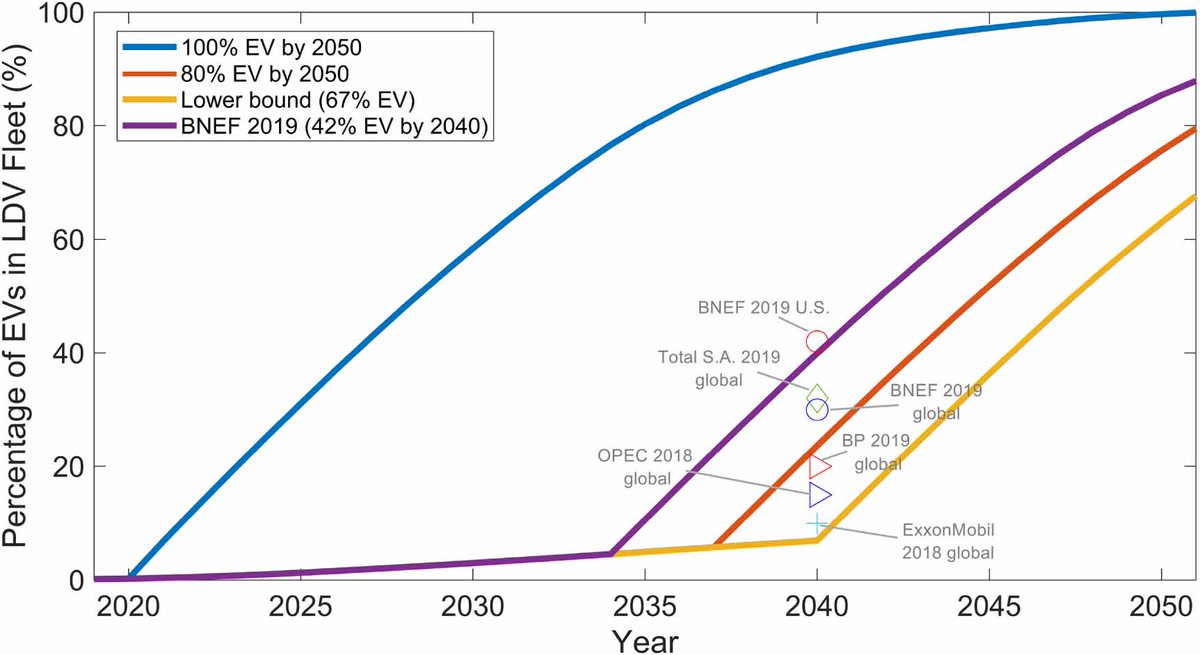I want to tell a story about climate change, cars, & how much we drive. We published a new paper on this, led by @CMU_CEE PhD student @AbArfaj & co-authored by @CMU_EPP Prof. Mike Griffin. We can& #39;t manage climate change without evolving our cars. https://iopscience.iop.org/article/10.1088/1748-9326/ab7c89">https://iopscience.iop.org/article/1... Thread-->
OK, we know there are lots of cars & SUVs– 250 million+ in the U.S. alone– and they& #39;re on the road for many years. And we know to decarbonize the vehicle fleet, we have to electrify travel and decarbonize the grid. Easy enough, we& #39;ll get to some numbers on how to do this. But...
But there& #39;s a third leg in the carbon stool: how much we drive. We& #39;re projected to drive about 3.3 trillion with a T miles in cars and SUVs in 2050 in the U.S. We drive a little under 3 trillion/year now. A lot of these miles have to be electric by 2050 to reduce GHGs by 80-90%+
Is an 80-90% GHG reduction by 2050 good enough? No, it needs to be zero, but we& #39;ll come back to this. For now let& #39;s just get to 80-90%.
Here& #39;s some numbers: If the grid had zero carbon, we need 67%-84% of our car travel to be electric in 2050 to reduce GHGs by 80 or 90%, respectively. As the grid carbon intensity moves away from zero (going up the orange dashed lines) the amount of electric travel needed goes up.
But we often don& #39;t think about total travel in decarbonization- if total travel goes up (due to sprawl/automation/uber/etc) it makes decarbonization harder. If we reduce total travel through urban design, incentives, transit, & shared mobility, it makes decarbonization easier.
Can we electrify 67-84%+ of car travel by 2050? I hope so. But remember that& #39;s 29 years away. Not that long! Actions to reduce or shift car travel are a decarbonization insurance policy against slower progress in electrification & uncertainty in how automated vehicles are used.
If we increase vehicle miles traveled (VMT) from 3.3 to 4 trillion in 2050– say because of automated robotaxis or lots of new highways – we need to have 73% EV travel to meet an 80% GHG reduction. But if we reduce VMT to 2.2 trillion we only need about 50% EVs. Still a lot!
About two-thirds of VMT are in "urban areas". About 1/3 of all VMT (~1 trillion VMT) is from the states with the 10 most populous cities. These regions could make a big impact on decarbonization by reducing VMT. Eliminate VMT from those states gets us to the dashed line.
One way to reduce VMT is to increase the load factor in cars (average number of people in a car on a trip, which is currently 1.6), and by having shared trips we get the same passenger miles with fewer vehicle miles. Better transit, design, & active transport are also essential.
Getting a lot of EVs on the road takes time. The average age of cars on the road is ~12 years, but the distribution has a long tail-- some cars that stay on the road 15, 20, even 30 years. Cars are not phones, they& #39;re the 2nd or 1st (after a home) most expensive asset people own.
Even after full depreciation, cars provide mobility services, and most families aren& #39;t going to shell out $30k+ for a new EV because a spreadsheet says (correctly) an EV has a lower discounted cost per mile, when their existing capital asset (a gas car) is working fine.
**Without policy** to buy back gas vehicles, the year that we have to start selling only EVs to have a 100% electric fleet by 2050 is...2020. Now maybe we don& #39;t need 100% EVs, and we could wait until the late 2030s to start selling only EVs and we could get 65-80% EVs by 2050.
But no matter what, the fleet turnover time is a bottleneck to transport decarbonization. To make big progress by 2030, we& #39;re going to need a big EV/e-bike for clunkers program. If new car sales were all EVs starting in 2021, more than half the fleet would be electrified by 2030.
But between 110 & 125 million gas cars would still be on the road in 2030. Using the Cash for Clunkers average tax credit of about $4200 in converting it to today& #39;s dollars, the resulting estimated cost of scrapping these gas cars in 2030 would be approximately $550–600 billion.
We purposefully omitted life cycle GHGs (an area we work on a lot). The production of an EV and its battery can generate about 7-10 metric tons of GHGs (making a gas car produces about 6-7 tonnes), the production and distribution of gas generates an additional 2.66 kg GHG/gal.
But even if vehicle & battery production GHGs dropped to 3 tonnes, every 10 million EVs sold would generate a GHG pulse of 30 million tonnes before they drove their first mile. This highlights the need for cross-sector industrial deep decarbonization *during the transition*.
To increase the likelihood of achieving the deep decarbonization of the passenger vehicle sector, the policies around the future of travel demand deserve more attention. Much of the structural space is determined locally with similar long-term timelines for change.
Land use and housing policy, walkability and community design, the historical prioritization of parking, the structural racism and inequities resulting from infrastructure development and fuel production– all of these affect and are affected by how much we drive.
Federal/state/& local policy can incentivize low-impact outcomes, as well as invest in expanded intercity and intracity electrified transit options, encourage congestion and road pricing, cycling, walking, and other methods to shift and reduce travel demand.
Vehicle automation brings another layer of new challenges & opportunities to transportation decarbonization. Prioritizing electric, shared, and low-impact automation that leverages public transit enables the potential for enhancing existing mobility while reducing total VMT.
And of course we don& #39;t need a 90% GHG reduction, it has to be 100% or more. And it needs to be equitable and just. We& #39;re going to need everything we got to do this- more transit than you think is possible, more EVs than you think. Let& #39;s get it done. /end https://iopscience.iop.org/article/10.1088/1748-9326/ab7c89">https://iopscience.iop.org/article/1...
Appendix: Some folks are reading this thread and concluding "EVs can& #39;t save us". That& #39;s true, EVs alone can& #39;t save us-- we& #39;re gonna need to 5-20x transit, walking, biking, access, density, and sharing. But the carbon reduction math says we& #39;ll also need a bunch of EVs. Like, a lot

 Read on Twitter
Read on Twitter






